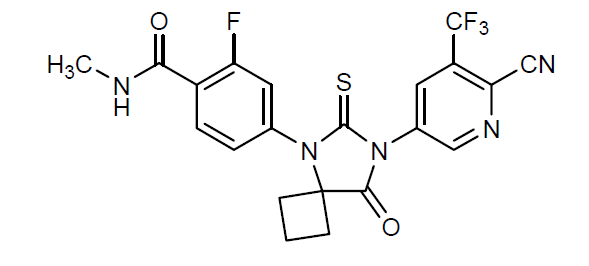Pregnancy
category X (Contraindicated) Biological half-life 3–4 days PubChem CID 24872560 Molar mass 477.4347 g/mol | Routes of
administration Oral CAS Number 956104-40-8 ChemSpider 28424131 | |
 | ||
Apalutamide (INN) (developmental code name ARN-509, also JNJ-56021927) is a non-steroidal antiandrogen that is under development for the treatment of prostate cancer. It is similar to enzalutamide both structurally and pharmacologically, acting as a selective competitive antagonist of the androgen receptor (AR), but shows some advantages, including greater potency and several-fold reduced central nervous system permeation. Apalutamide is (since 2014) in phase III clinical trials for castration-resistant prostate cancer.
Contents
Side effects
Apalutamide has been found to be well-tolerated in clinical trials thus far, with the most common side effects reported including fatigue, nausea, abdominal pain, and diarrhea.
Antiandrogen
Apalutamide is a silent antagonist of the AR and possesses 5- to 10-fold greater affinity for the AR than bicalutamide.
Resistance in prostate cancer
Recently, the acquired F876L mutation of the AR identified in advanced prostate cancer cells was found to confer resistance to both enzalutamide and apalutamide. A newer antiandrogen, darolutamide (ODM-201), is not affected by this mutation, nor has it been found to be affected by any other tested/well-known AR mutations.
Apalutamide may be effective in a subset of prostate cancer patients with acquired resistance to abiraterone acetate.
Cytochrome P450 inducer
Apalutamide shows potent induction potential of CYP3A4 similarly to enzalutamide.
GABAA receptor negative modulator
Apalutamide binds weakly to and inhibits the GABAA receptor in vitro similarly to enzalutamide (IC50 = 3.0 and 2.7 μM, respectively), but due to its relatively lower central concentrations, may have a lower risk of seizures in comparison.
Pharmacokinetics
The mean terminal half-life of apalutamide at steady-state is 3 to 4 days.
Chemistry
The chemical structure of apalutamide is similar to that of enzalutamide.
